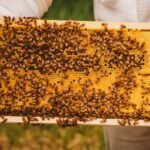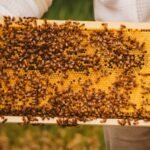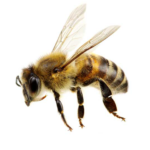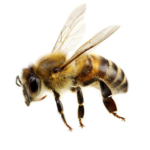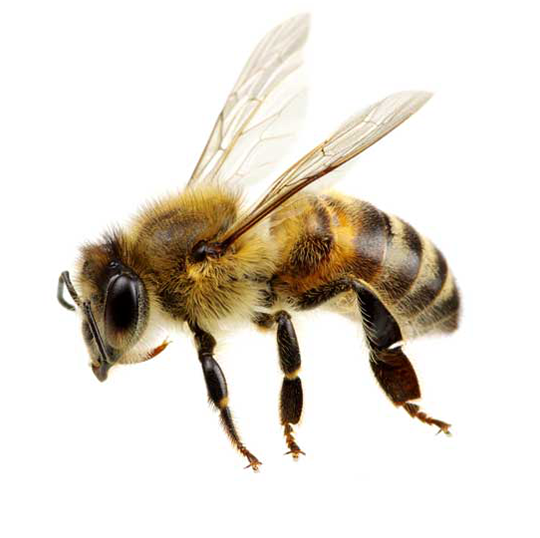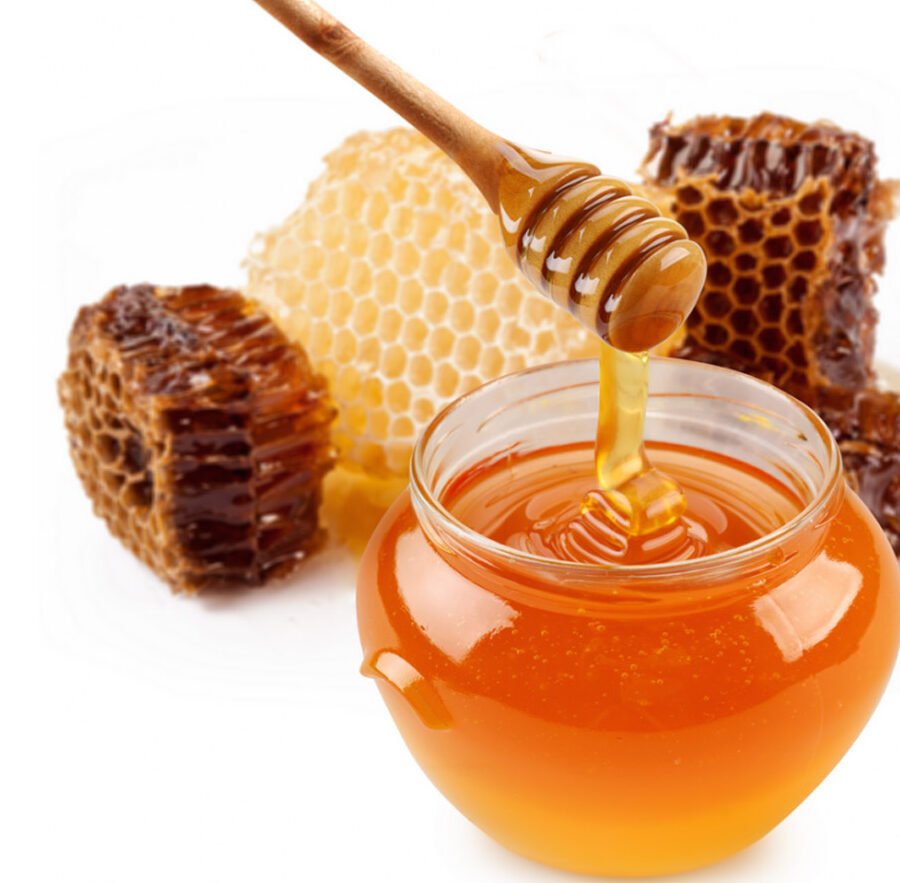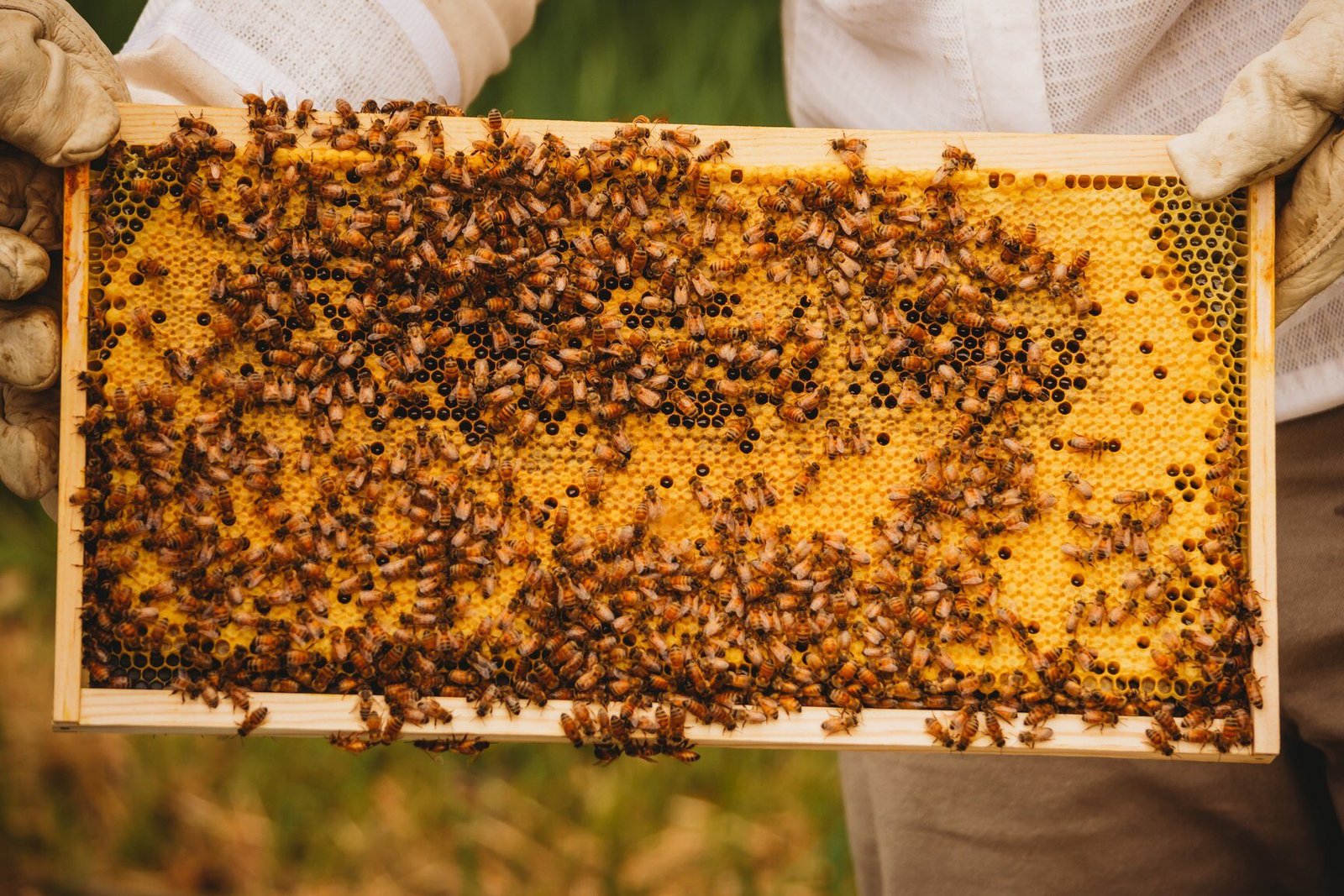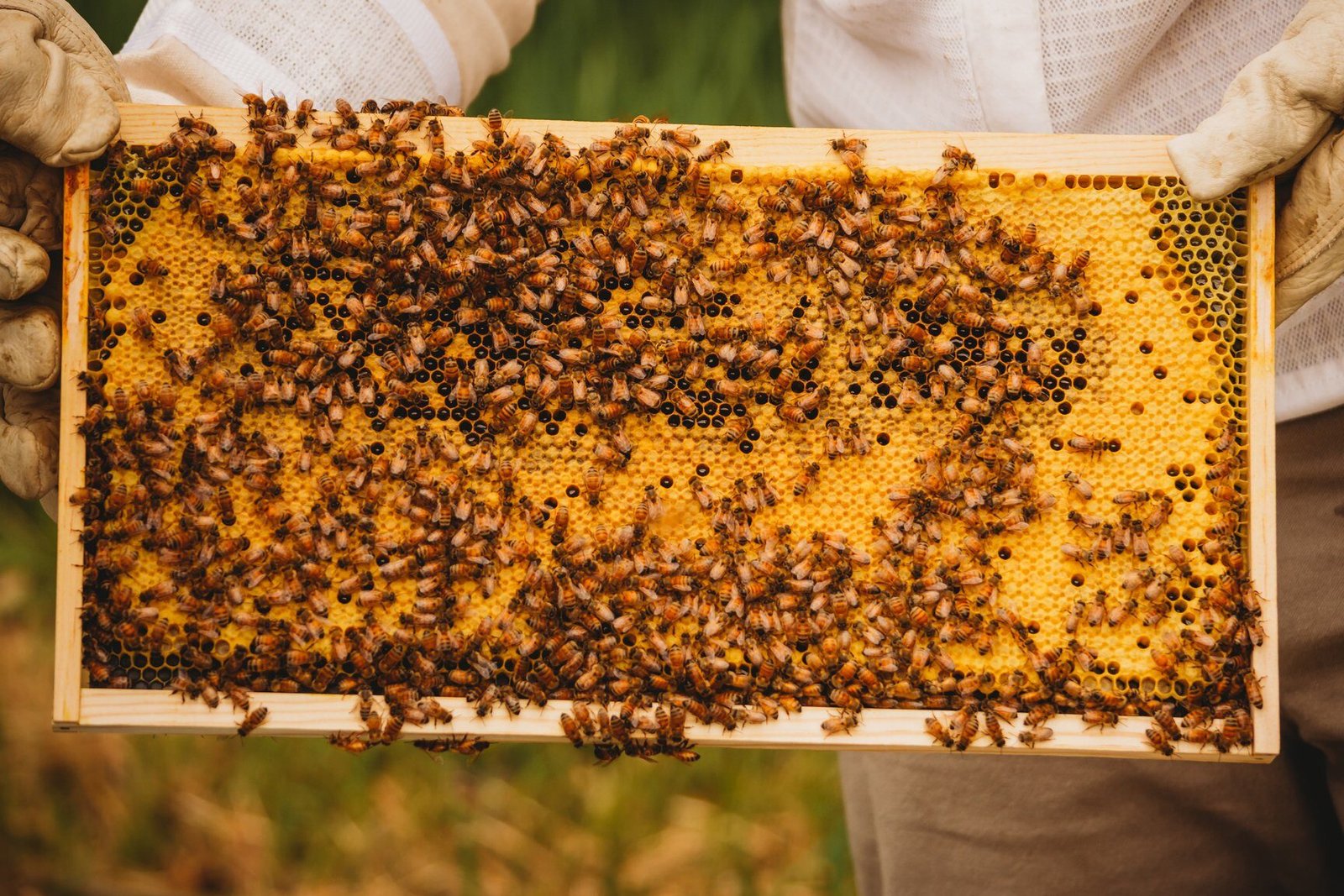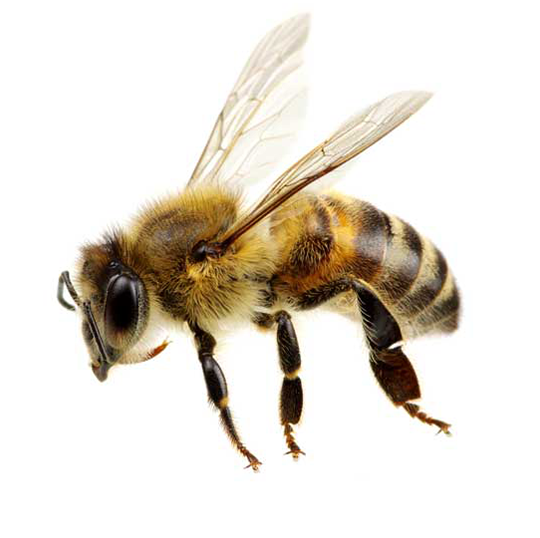Sustainable honey production serves as a cornerstone for enhancing biodiversity while ensuring healthy bee populations thrive. By emphasizing pollinator health, beekeepers can effectively address threats such as habitat loss and pesticide exposure.
Implementing ecofriendly hives allows producers to minimize their ecological footprints while yielding top-tier honey.
Key strategies include:.
- Integrated pest management to control pests naturally.
- Creating forage habitats that support bee biodiversity.
- Encouraging diverse crops around apiaries to boost forage diversity.
- Implementing regenerative practices that restore soil health and ecological balance.
Promoting bee biodiversity benefits local agricultural outputs, paving the way for a greener future.
Organic Beekeeping Techniques For Beginners
Embarking on an organic beekeeping journey offers many rewards. Organic beekeeping emphasizes healthful practices that nurture both bees and nature. The following foundational techniques are essential:
- Choosing an optimal location: Ensure abundant sunlight and shelter from harsh winds.
- Selecting sustainable hive designs to enhance working conditions for bees.
- Utilizing natural feeding options supports honeybee nutrition in challenging seasons.
- Regularly monitoring hive health through chemical-free management promotes resilience.
These practices foster an environment where bees flourish and beekeepers thrive. Emphasizing bee-friendly practices, such techniques pave the way for successful small-scale apiculture.
As you venture into organic beekeeping, remember that community education and awareness are vital for promoting sustainable practices. By prioritizing environmental stewardship, beekeepers contribute to habitat restoration and broader ecological benefits.
How Pollinator Health Affects Honey Production
The health of pollinators plays a significant role in the success of honey production. Pollinator populations, particularly honeybees, are essential for the fertilization of over 75% of the world’s flowering plants.
These vital insects encounter various challenges including habitat loss and exposure to pesticides, which can severely affect honey yield and quality.
Healthy bee colonies are fundamental; they directly influence the diversity of floral resources and the overall well-being of ecosystems.
By implementing sustainable beekeeping practices, beekeepers can enhance pollinator health, leading to an increase in both the quantity and quality of honey.
Key elements that influence honey production include:
- Pollen availability from pollinator-friendly plants
- Management of pests through integrated pest management
- Promotion of biodiversity enhancement
- Support for bee habitat conservation and natural foraging
Implementing these practices not only improves honey production systems but also supports local ecosystems and promotes biodiversity. Fostering a healthy environment for bees is crucial for sustainable honey production and ecological balance.
Ecofriendly Hives: Design Considerations
Design considerations for ecofriendly hives significantly impact sustainable honey production. Innovative approaches to hive design can greatly reduce the ecological footprint associated with beekeeping.
Utilizing renewable materials such as untreated wood or bamboo not only promotes organic beekeeping but also enhances the durability of hives. Proper ventilation is essential; it can help minimize disease risks, ensuring healthier colonies.
Strategies for Hive Design:
- Strategic hive placement: Positioning hives near areas with forage diversity enhances bees’ foraging conditions, leading to improved honey yields.
- Emphasis on biodiversity enhancement: Incorporating native plants around apiaries supports bee health and fosters ecological balance.
- Use of wax foundation: Promoting natural constructions can improve hive health and overall bee welfare.
- Implementing hive insulation: This helps maintain optimal temperatures, greatly benefiting bee colonies.
The transition to sustainable designs not only supports honeybee welfare but also fosters a significant impact on the ecosystem.
Innovative hive designs cater to the specific needs of bees, leading to enhanced productivity and honey quality.
By focusing on sustainable practices, beekeepers can ensure a better future for both their colonies and the environment.
Pollinator Health and Honey Production
- Over 75% of the world’s flowering plants rely on pollinators for fertilization.
- Healthy bee colonies increase the diversity of floral resources, which is crucial for ecosystem well-being.
- Implementing sustainable beekeeping practices can enhance both the quantity and quality of honey produced.
- Strategic hive placement near diverse forage areas significantly improves honey yields.
Ethical Honey Sourcing: What To Look For
When selecting honey, consumers increasingly prioritize the sources from which it comes. Ethical honey sourcing emphasizes the well-being of bees while promoting environmental health.
This approach ensures that honey production methods do not lead to habitat destruction or chemical exposure.
Look for certifications such as organic and Fair Trade, as these labels indicate responsible practices that align with sustainable beekeeping.
Support for local beekeepers often means access to ecofriendly hives and initiatives that enhance biodiversity enhancement. These practices not only improve pollinator health but also enhance the overall quality of honey.
Making informed decisions contributes to fostering a healthier ecosystem for the future.
Biodiversity Enhancement For Healthy Bees
Creating rich and diverse ecosystems is essential for nurturing robust and resilient bee populations. Enhancing biodiversity provides various floral diversity, which is critical for the nutrition and wellbeing of honeybees.
Both planting native plants and promoting organic beekeeping can significantly boost foraging environments crucial for bee health.
Local community initiatives, such as establishing pollinator gardens, play a significant role in enhancing bee habitat conservation.
Collaboration among beekeepers, farmers, and environmental advocates supports sustainable practices that benefit local ecosystems. By prioritizing biodiversity, stakeholders not only ensure honeybee welfare but also secure the agricultural practices necessary for maintaining a thriving environment conducive to all pollinators.
Sustainable Honey Production Practices
Sustainable honey production practices focus on adopting environmentally-friendly methods that protect bee health and support biodiversity.
Employing organic farming techniques helps prevent chemical contamination in both hives and nearby flora. Integrated pest management (IPM) allows for natural and sustainable disease control within hives.
Encouraging crop diversity around apiaries significantly enhances bee foraging opportunities and overall ecosystem vitality.
Strong support for local honey production reduces the carbon footprint associated with transportation.
This practice, in combination with regenerative agriculture techniques, restores soil health and fosters better environmental conditions.
Water conservation strategies further minimize impacts on local water sources while promoting the health of bee populations.
Engaging in community education is essential for raising awareness about the importance of sustainable beekeeping. Proper hive management ensures the well-being and productivity of bee colonies, leading to healthier ecosystems and greater agricultural yields.
Collaborative efforts involving beekeepers, environmentalists, and policymakers are crucial for promoting sustainability and enhancing overall bee biodiversity.
| Aspect | Details |
|---|---|
| Certifications | Look for organic and Fair Trade labels for responsible honey sourcing. |
| Biodiversity Benefits | Enhancing floral diversity is critical for honeybee nutrition and wellbeing. |
| Sustainable Practices | Employ organic farming and integrated pest management to protect bee health. |
| Community Impact | Local initiatives like pollinator gardens enhance bee habitat conservation. |
Natural Foraging: Best Practices For Beekeepers
Effective foraging strategies are essential for enhancing bee productivity and health. Implementing diverse plantings within your apiary attracts a variety of pollinators, which is crucial for robust hive development.
Creating habitats that feature native plants significantly boosts biodiversity enhancement, enhancing ecosystems vital for sustaining bee populations.
Planting seasonal flowering plants guarantees a continuous nectar flow, supplying resources across different seasons.
Designated forage areas optimize foraging opportunities and lead to healthier hives. By focusing on ecological sustainability, beekeepers can improve overall bee welfare while contributing to environmental stewardship, which ensures ethical honey sourcing.
Natural foraging supports the foundation for organic beekeeping, allowing for better hive health management and enhancing pollinator health.
The Role Of Regenerative Agriculture In Beekeeping
Regenerative agriculture practices significantly influence beekeeping outcomes and enhance ecological harmony. Incorporating regenerative techniques enriches soil health, which directly impacts the availability of pollinator-friendly plants.
Encouraging crop diversity around apiaries fosters a healthy ecosystem, providing bees with abundant foraging options that boost honey production systems.
Collaborations between farmers and beekeepers promote pollinator health, ensuring that agricultural yield and hive productivity thrive together.
Reducing chemical usage in farming not only protects bees but also cultivates healthier habitats. Implementing proper hive management guarantees the well-being and vitality of bee colonies while fostering local honey benefits.
These synergistic efforts generate sustainable honey production and enhance the resilience of both agriculture and bee populations through practices that highlight biodiversity and ecosystem services.
Beekeeping and Foraging
- Diverse plantings can increase bee productivity by up to 50%.
- Native plants can improve local biodiversity, benefiting over 30% of pollinator species.
- Seasonal flowering plants ensure a continuous nectar flow, crucial for hive health.
- Regenerative agriculture can increase soil health, leading to a 20% increase in pollinator-friendly plants.
Bee Habitat Conservation Strategies Explained
Effective conservation strategies are essential for thriving bee populations. Habitat restoration plays a pivotal role, focusing on replanting native plants to enhance forage availability and biodiversity enhancement.
Implementing pesticide reduction policies fosters healthier ecosystems while minimizing chemical exposure to these essential pollinators.
This approach supports integrated pest management, promoting sustainable bee health and reducing the ecological footprint of small-scale apiculture.
Engaging communities in creating pollinator pathways can bolster efforts by providing necessary forage, shelter, and water sources crucial for sustaining bee habitats. Such initiatives significantly contribute to maintaining ecological balance.
Community Engagement and Education
Community involvement is key in executing bee habitat conservation strategies.
Educating the public about bee welfare and the importance of environmentally-friendly practices helps encourage local participation. Workshops on beekeeping education can foster a deeper understanding of ecosystem services provided by bees and inspire actions to enhance pollinator-friendly spaces.
Why Native Plants Matter For Bees
Recognizing the importance of native plants is essential for supporting local bee populations.
These plants provide critical resources, offering nutrients and shelter that are important for bee survival.
Native flora attracts more pollinators due to their co-evolution with local species, thereby enhancing bee diversity and resilience in ecosystems.
Native plants contribute to biodiversity enhancement, ensuring that diverse ecosystems remain less susceptible to diseases and pests.
Benefits of Native Plants
- Forage diversity enhances food sources for bees throughout their life cycles.
- Seasonal flowering provides continuous blooms, supporting bees during varying seasons.
- Native plants can improve soil health, which is critical for overall ecosystem stability.
By planting natives across urban and rural landscapes, communities can adopt sustainable practices that benefit bees and support local honey production. Engaging in methods such as permaculture and regenerative agriculture can restore habitats and ensure the long-term health of bee populations.
| Conservation Strategy | Impact on Bees |
|---|---|
| Habitat Restoration | Enhances forage availability and biodiversity |
| Pesticide Reduction Policies | Minimizes chemical exposure and supports bee health |
| Community Engagement | Increases local participation in pollinator-friendly practices |
| Native Plant Usage | Provides critical resources and improves ecosystem resilience |
Chemical-free Management Practices For Honeybees
Implementing chemical-free management practices is vital for fostering healthy honeybee populations. Beekeeping methods that avoid synthetic pesticides not only promote bee welfare but also enhance overall ecosystem services.
Adopting integrated pest management (IPM) techniques enables beekeepers to manage pests sustainably while minimizing chemical exposure.
This approach is complemented by using natural deterrents, such as essential oils, which present eco-friendly alternatives to traditional pest control.
Enhancing Bee Nutrition Through Diverse Habitats
Creating diverse habitats filled with pollinator-friendly plants significantly boosts foraging opportunities for honeybees.
This diversity improves both their nutrition and resilience against environmental stressors. Moreover, biodiversity enhancement contributes to sustainable honey production practices, ensuring that bees have access to a variety of food sources throughout their lifecycles.
“Healthy bee populations are the cornerstone of sustainable agriculture and honey production. ”
Promoting Sustainable Practices
Utilizing organic beekeeping methods helps prevent chemical contamination of hives and surrounding flora.
By engaging in crop rotation and maintaining forage diversity around apiaries, beekeepers can significantly improve pollinator health. Incorporating regenerative agriculture techniques not only restores soil health but also enhances the overall environmental conditions in which bees thrive.
Community and Education
Raising awareness and engaging in beekeeping education play a crucial role in promoting sustainable practices.
Local honey production not only reduces the carbon footprint associated with transportation but also supports community-supported agriculture.
By prioritizing responsible harvesting and hive health monitoring, beekeepers can ensure the longevity and productivity of their colonies.
Ultimately, prioritizing ethical honey sourcing and adopting bee-friendly practices contribute to healthier ecosystems and improved honey quality.
By focusing on sustainable honey production systems, beekeepers can safeguard the future of both their craft and the vital pollinators they depend on.
Chemical-free Management Practices for Honeybees
- Beekeeping methods that avoid synthetic pesticides can reduce bee mortality rates by up to 50%.
- Diverse habitats with pollinator-friendly plants can increase honeybee foraging efficiency by 30%.
- Implementing organic beekeeping practices can improve hive health and productivity by enhancing genetic diversity.
- Community-supported agriculture initiatives can lead to a 20% increase in local honey sales, reducing transportation emissions.

